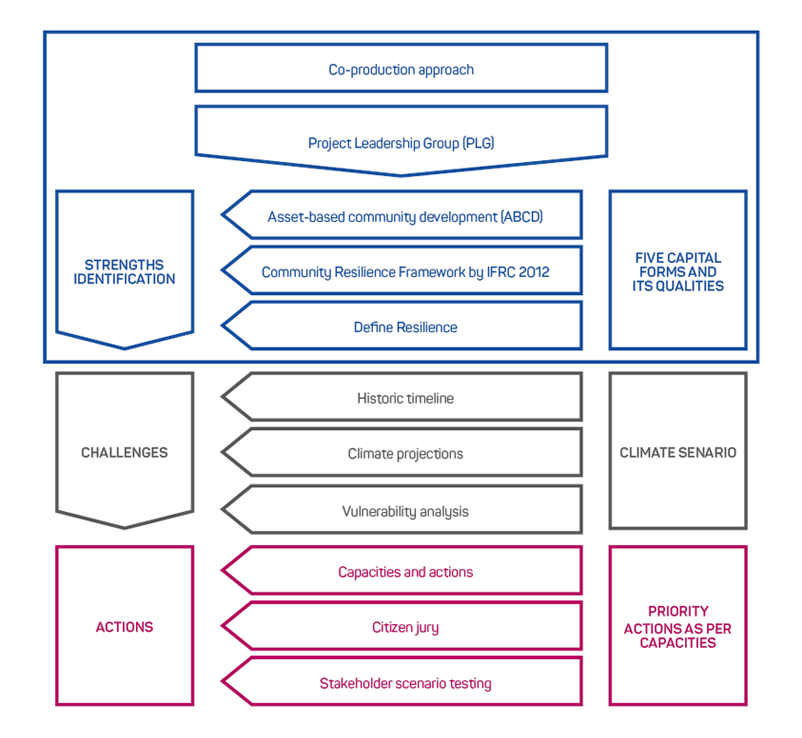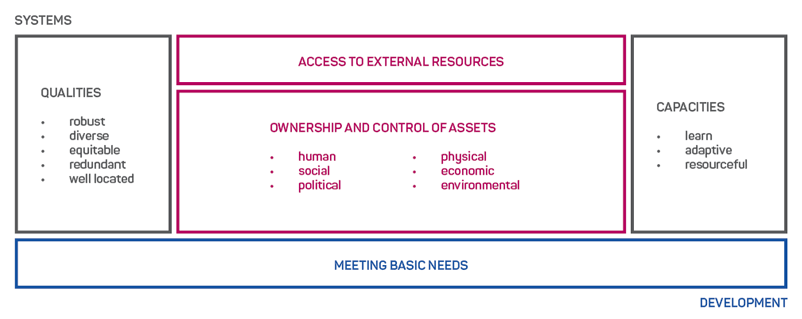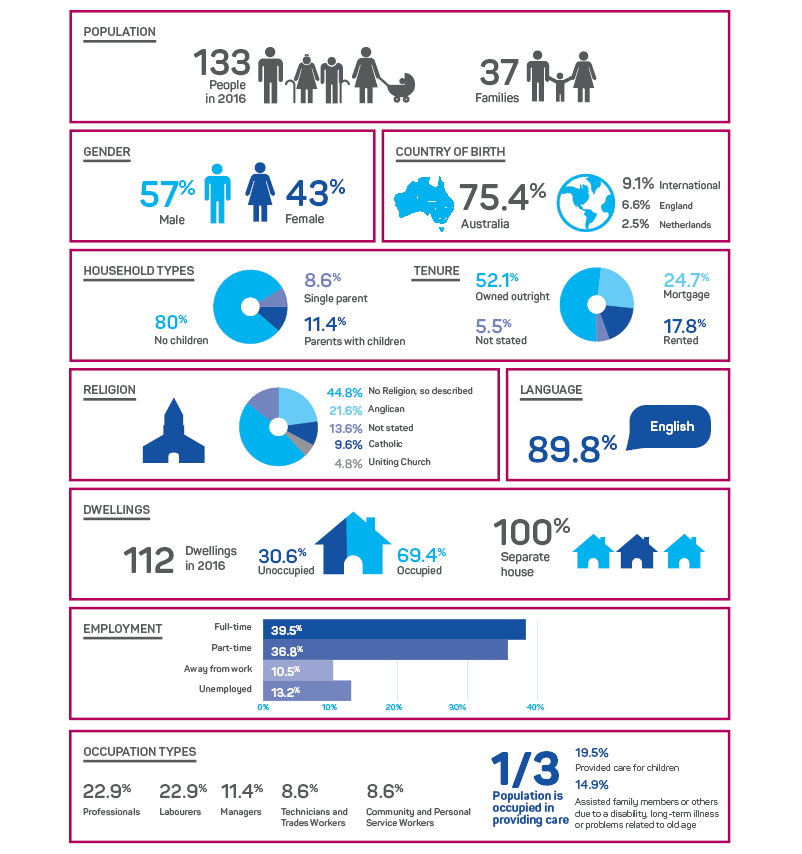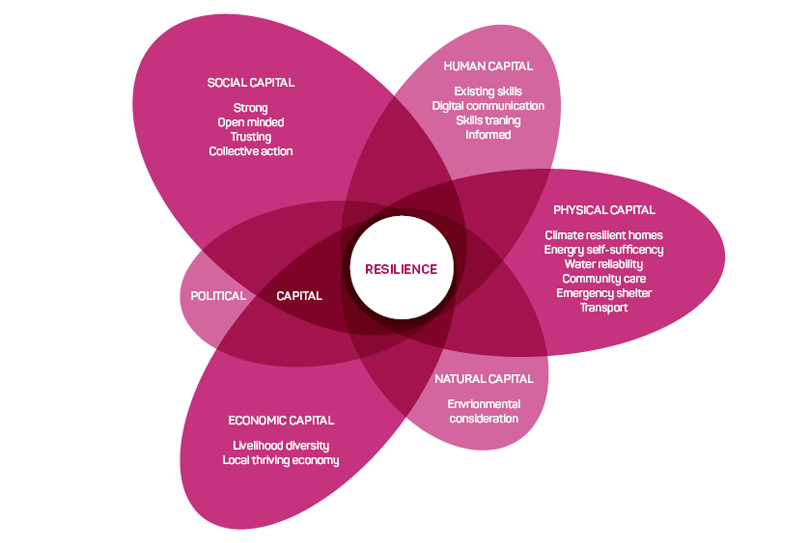In 2018, the Tarnagulla Alternative Energy Group in regional Victoria took steps to plan futures for their town and its local community that strengthened resilience to many challenges in the area including those from climate change. Believing that ‘anticipation strategies work against known problems, while resilient strategies are better against unknown problems’ (IFRC 2012, p.5) the group turned to the RMIT Climate Change Transformations group to unpack the meaning of resilience as it related to the town and community. The purpose was to produce a locally-focused Resilience Action Plan. Despite an international consensus and media propagation of resilience as a silver bullet to address future uncertainties, the concept remains contentious and challenging to implement. This paper considers how the various framings of resilience—the ‘conceptual’ (in literature) and the ‘operational’ (in policy)—relate to the Tarnagulla community’s lived experience and the implications. The comparison allows to unpack a mixture of the complexities in understanding the nature of values, preferences, expectations, capacities, contested knowledge, as well as, the uncertainties. Study findings show that communities are best placed to frame their resilience, collectively and from a ‘systems’ perspective, and that implementing actions, which may require radical change, hinge on a political voice and sustained support from policy makers.
Based on a presentation at AFAC19 - the annual conference of AFAC and the Bushfire and Natural Hazards CRC.
Introduction
Tarnagulla is a small rural town in central Victoria, which is nestled within Box-Ironbark forests. Tarnagulla, similar to other rural communities, faces many risks. These include ongoing ‘general’ challenges related to
the town’s development or ‘climate-related’ challenges. According to the Intergovernmental Panel on Climate Change (IPCC), climate change is expected to increase the frequency and intensity of extreme weather events (IPCC 2014) and exacerbate present challenges. The Tarnagulla alternative energy group (TAEG) community group wanted to proactively plan a future they wish to have and become resilient. However, they did not have a clear understanding of what constitutes ‘resilience’ and the process of strengthening it.
This paper asked the question: ‘how does the Tarnagulla community’s definition of resilience based on lived experiences relate to those within the relevant literature?’
This paper reports on the Tarnagulla community’s understanding and definition of resilience. This constitutes preliminary findings of an action-research project titled ‘Resilience Action Plan for and by the Tarnagulla Community’. The framing and defining of resilience used by three different groups (academia, government and communities) are discussed and compared to identify the resilience of what, of whom, by whom, when and how. The comparison allowed an unpacking of the inherent complexities in the definition; the values, preferences, expectations, capacities and contested knowledge. The findings have implications for those working in the disaster risk reduction sector. Of importance is the need to frame resilience collectively and to have a shared goal (communities, practitioners, policy makers and researchers), which has potential for communities to adapt to uncertain futures.
Method
A predominantly qualitative methodology was used to investigate the research question. There was limited use of quantitative methodologies. The action-research approach means the research is intertwined with actions taken through co-production approach. This methodology is appropriate considering resilience cannot be imposed on a community by externally stakeholders in a top-down manner; communities must be empowered to take collective action. A co-production method assists to frame resilience collaboratively and the project is process-driven and outcome-oriented.
Seven local people from the TAEG became the Project Leadership Group. The idea of a leadership group comes from insights from the community development (e.g. asset-based community development approach by Krezmann & McKnight 1993) that indicates the benefits of a core group to serve as a backbone for any project. The Project Leadership Group worked as a conduit between the RMIT and the community, making sure the project ran smoothly and acted as a community champion. The blue box in Figure 1 shows the topics covered in the study.
To define resilience, this research adopted a theoretical framework for ‘community resilience’ developed by the International Federation of Red Cross and Red Crescent Society (IFRC) (2012), whereby community resilience relies on:
- basic needs
- consideration for six capital forms (i.e. human, social, economic, natural, physical and political)
- qualities of these capital forms (i.e. robustness, diversity, equity, redundancy and are well-located)
- capacities to learn, be adaptive and be resourceful (Figure 2).
These capital forms, their qualities and capacities were used to unpack resilience concepts (strengths identification, highlighted in blue in Figure 1).
Both qualitative and quantitative data for stage one (strengths identification) were collected through one, three-hour co-production workshop, one community event and two surveys (blue outlined phase in Figure 1). Focus group discussions with the Project Leadership Group accompanied these activities. With permission from participants, discussions were audio recorded, activities completed on butcher’s paper were scanned and people’s photographs were taken. Quantitative data to demonstrate participation was gathered through sign-in sheets during each event and through two survey questionnaires; one at the start of the project to define resilience and a second midway into the project. The first survey was delivered in a play-based way. The second survey was conducted via printed forms available at the local Post Office as well as online. The purpose of the surveys was to assess the participation, commitment and change in perceptions and values of the respondents during the project. Over 120 members, including the Tarnagulla community and stakeholders, either living, working or related to the Tarnagulla township, participated in the project. Thematic content analysis was used for the qualitative data and clustered into capital forms based on the IFRC (2012) community resilience framework. The project received RMIT College Human Ethics Advisory Network approval, CHEAN B 21763-10/18.
Significance of framing for resilience concept
The concept of resilience has etymological roots in the Latin verb resilire meaning ‘to rebound or recoil’. Broadly, it refers to a capacity to ‘bounce back’. In the 1970s, the concept was introduced to disaster and risk management. Since that time, the concept has been widely adopted as evidenced in the Sendai Framework for Disaster Risk Reduction 2015–30 (UNISDR 2015). A key contribution of the resilience concept is the introduction of a systems-based approach and a long-term view and promotion of multi-sectorial, multi-disciplinary and multi-scalar interactions. While the systems-based resilience concept has led to the convergence of previously divergent disciplines, sectors and scales (encapsulated in hazards, disasters, risk management, sustainable development, climate change and climate adaptation studies), the concept remains contentious.
The resilience concept is also used in the disciplines of human psychology, engineering, ecology, finance and business. Such proliferation in diverse disciplines has meant it is understood differently. This makes
its implementation in practice very challenging. Some scholars (e.g. Bahadur & Tanner 2014, p.202) suggest that resilience lacks a ‘normative dimension’. Consequently, others (e.g. Cascio 2009, Folke 2006, Smit & Wandel 2006, Walker & Salt 2006) agree that clarification of resilience to what, of whom, by whom, when and how is required if the concept is to have real significance.
concept of framing is useful to unpack the complexity of resilience as it is intimately linked to sense-making processes. McEvoy, Fünfgeld & Bosomworth (2013) claim that ‘framing occurs when people with different knowledge, experiences and personal backgrounds consider a common challenge and attempt to make sense of it from their individual or organizational perspective’ (p.28–82). The process of framing allows people with different mindsets and backgrounds to reach consensus on a problem. Typically, framings occur at three levels:
- meta-level
- conceptual
- operational.
At the meta-level, framing concerns ‘normative’ understandings as broadcast by media. Conceptual framing is provided by scholars while operational framing by practitioners or policy makers. Meta-level framing is beyond the scope of this paper. Here, the focus is on conceptual and operational framing as well as the Tarnagulla community’s framing of resilience based on lived experiences.

Figure 1: Methodology for the Resilience Action Plan for and by the Tarnagulla community (blue box shows the topics that are discussed in this article).

Figure 2: Conceptual framework for community resilience.
(IFRC 2012, copyright permission granted)
Conceptual framing
A review of literature since the 1970s reveals three conceptual framings of resilience (see Table 1). These framings of resilience are based on three disciplinary lenses:
- engineering (hard science)
- social science (soft science)
- socio-ecological (inter-relationships) (Vahanvati & Rafliana 2019).
Similarly, Handmer and Dovers (1996, p.495–96) proposed three typologies of resilience based on a society’s response to threats or disturbance. These were:
- resistance and an inability to change
- change at the margins
- openness, adaptability and radical change to social and institutional structure.
These framings are represented in Table 1.
Conceptual framing 1: Engineering (hard science)
Engineering, or hard science, framing of resilience relates to the physical assets or a material’s rate of return to a state of equilibrium after a small disturbance. Examples of engineering resilience include rebuilding of robust houses or building sea walls to protect coastal towns from inundation. The characteristics of hard science-based framing of resilience is a resistance to change. That is, resilience maintains one state of equilibrium, which is a linear view.
Conceptual framing 2: Natural (social science)
The resilience concept found its roots in natural science, informed by the work of the Canadian ecologist, Holling (1973) and later through the Resilience Alliance.1 Holling (1973) defined ecosystem resilience as:
The capacity of a system to absorb and use or even benefit from perturbations and changes that attain it, and so to persist without a qualitative change in the system’s structure.’
Holling (1973)
In natural sciences, resilience is a system’s capacity to function either by withstanding or adapting to a changing environment by making minor changes. Essentially, ecosystem resilience is the ability of a species,
flora, populations and overall systems to maintain functioning in fluctuating or adverse environments. The characteristics of ecosystem resilience are adaptive capacity, multiple equilibrium states and a non-linear view of achieving it (Handmer & Dovers 1996, Holling & Walker 2003). However, the ‘rate’ or ‘magnitude’ of change the system can withstand is questionable.
The social science framing of resilience differs from the ecological framing as humans can imagine, forecast and forward-plan due to an embedded ‘social memory’ (Folke 2006, p.253). Social resilience is the individual’s or the collective ability to maintain functioning and also attain a ‘desired’ future trajectory by anticipation, planning and adaptation, which transcends spatial and temporal boundaries (Mulligan et al. 2016). The social sciences framing of resilience has come under lot of criticism, as it promotes a ‘negative anti-community individualism’ and ‘self-reliance’ (Davoudi et al. 2012, Mulligan et al. 2016, p.1).
Conceptual framing 3: Socio-ecological systems
Socio-ecological systems framing is a recognition of inter-relationships between the social, ecological, economic and political systems. This resilience perspective ‘enhances the likelihood of sustaining desirable pathways for development in changing environments where the future is unpredictable’ (Adger et al. 2005, Folke 2006, p.254). Resilience to climate change is defined by the UN-Habitat (2014) as:
The ability of a social or ecological system to absorb disturbances while retaining the same basic structure and ways of functioning, the capacity for self-organization, and the capacity to adapt to stress and change.
UN-Habitat (2014)
In this definition, socio-ecological systems resilience is the ‘resilience to’ climate-related disturbances and being able to maintain societal functioning when faced with disturbance or uncertainty. For example, a resilient socio-ecological system is a region that is ecologically, economically and socially sustainable. Socio-ecological systems resilience relates to (see Figure 2):
- meeting society’s basic needs
- considering all asset types (human, physical, natural, economic, political and social)
- enhancing capacities to learn, adapt and change
- have qualities of robustness, diversity, equitability, redundancy and be well-located.
Operational framing of resilience
Implementing resilience for risk management are guided by international organisations such as the United Nations. Similar to academic discourse, the international inter-governmental and government discourse around resilience and risk management has progressed substantially since the 1994 World Conference on Natural Disaster Reduction. The emphasis has shifted from response to prevention and from short-term to continuous, long-term and multi-disciplinary efforts.
All levels of Australian government adhere to United Nations protocols and actions. However, the commitment to action has varied. In the 1960s, there was a shift in focus from war-affected to disaster-affected communities. In 2009, the National Emergency Management Committee was established by the Council of Australian Governments and in 2011 the National Strategy for Disaster Resilience (NSDR) was formulated to develop coordinated and cooperative efforts. While a ‘multi-hazard’, ‘multi-agency’ and ‘whole-of-lifecycle’
(Prevention, Preparedness, Response and Recovery) approach to disaster risk management (McEvoy et al. 2013) is advocated, the NSDR did not define resilience. Rather, the NSDR (Attorney-General’s Department 2011, p.4) describes the characteristics of community resilience as:
- well-functioning under stress
- successful adaptation
- self-reliant
- social capacity.
The NSDR resilience characteristics as well as the Emergency Management Victoria definition of resilience (Emergency Management Victoria 2017, p.47) align with the social framing of resilience. Such framing can lead to governments devolving responsibility to communities.
Australian policy has come a long way from a narrow view of defending society during or following emergency events (i.e. post-event response) to pre-event (i.e. prevention). Yet there is a dominant focus on emergencies and response rather than prevention, which suggests an overall lack of focus on framing resilience from a socio-ecological-systems perspective and focusing on a whole-of-life approach to risk management.
Resilience as framed by the Tarnagulla community
To define resilience, the Tarnagulla community identified an agreed description of resilience; resilience to what, when, at what scale and of whom (Table 2). They also identified community strengths based on asset-based community development approach (Table 2).
Table 2 summarises the findings of what the Tarnagulla community valued and possessed. In response to resilience building ‘when’, 80 per cent of the Tarnagulla community participants proposed it as a continuous activity, not done before or after an event nor during times of need or prosperity. Participant quotes from the survey indicate the continuous nature of resilience activities:
The ability to manage the unforeseen in a manner that provides confidence to those effected and enables renewal in a purposeful manner that ensures that all concerns and all environmental aspects are considered.
(Project Leadership Group member)
Resilience is being ‘Progressive in adversities’
(Participant)

Figure 3: Infographic depicting the ‘general’ challenges facing the Tarnagulla community.
Source: Vahanvati and TAEG (2019).
In response to resilience ‘to what’, 80 per cent of participants agreed that the Tarnagulla community faces some pressing ‘general’ challenges as well as climate-related challenges. Figure 3 illustrates some of these challenges that include a declining and ageing population, unreliable amenities and infrastructure as well as long distances from business opportunities. In addition, one-third of the population is involved in caring for a family member.
Table 3 shows some of the ‘certain’ and ‘uncertain’ challenges facing the Tarnagulla community, both of which have ‘general’ and ‘climate-related’ challenges. ‘Certain’ challenges that relate to climate change include heat waves, increased bushfire risk, occasional floods, droughts and storms.
Participant response to ‘of who and what’ are illustrated in Figure 4. Social capital was the most important capital form to foster resilience. All participants said they valued their social capital and see it as important for resilience. For example:
Resilience is about the community trusting and respecting each other and working together to support those in need.
(Project Leadership Group member)
Personal view that refugees be invited [to settle in Tarnagulla]. Transport would be difficult although [there is a] weekly bus to and from Bendigo.
(Participant)
The Tarnagulla community is diverse in gender and age. Community members are active in volunteering and various community activities. They are open-minded and have welcomed refugees to settle in the town.
The community’s physical capital is identified as the second most important capital form to build resilience. While 80 per cent of participants said they are proud of heir 1960s heritage buildings, they also acknowledge that these buildings are ageing with 30 per cent being unoccupied and not designed for a changing climate. For example, the houses are not designed to withstand bushfire embers nor storms and heatwaves. The survey revealed that very few residents have houses insured for climate extremities. Locals think that low reliability of basic services and infrastructure has made their town unattractive. Challenges related to services include energy (longer power outages), potable water (currently getting low-pressure, gravity fed piped water from neighbouring town) and sanitation (septic tanks as the only option). Infrastructure challenges include minimal public transport and healthcare services (ambulance can take up to 45 minutes to reach the town). This project led to 80 per cent of participants wanting to make their houses robust, improve their access to amenities and beautify the town to attract people to live in the area, as shown:
Preservation/upgrade of historical look of [the] main road. Businesses are needed to encourage tourism/local economy.
(Participant)
More businesses/larger population/we need transport/medical and more help for the elderly.
(Participant)
Self-sufficient electricity supply or, at the least, some form of backup power.
(Participant)

Figure 4: Resilience ‘of who and what’ as defined by the Tarnagulla community.
Note: the size of the oval indicates the amount of significance placed on that capital form by the community.
Economic capital was identified as an equally important capital form to the physical capital to build resilience. Survey quotes suggest that participants discussed physical and economic capitals together. A few householders have started diversifying their livelihoods (e.g. starting bed and breakfast businesses or farmers having multiple sources of income (sheep rearing and crops)). Even so, there is still more to be done to attain a self-sustainable and thriving economy.
The Tarnagulla community’s definition and vision for the future, or what it would mean to be resilient, is:
The Tarnagulla community of the future will be different, and together we will work towards developing and sustaining a thriving town. We will have a strong social culture built on a diverse and connected population representing and welcoming peoples of all ages, status, ethnicities and interests. We will have a sustainable economy built on local agriculture, business, clubs, organisations and tourism. To be resilient we will have developed the necessary capabilities to confidently address our future.
(Project Leadership Group members)
This definition of what constitutes being resilient involves all capital forms. It is continuous and requires renewal of the town’s economy and physical capital. This requires ongoing commitment to adapt skills and capacities to meet contstantly changing and uncertain futures since there is not one future. These definitions fit under socio-ecological systems resilience framing.
Implications
The findings confirm that the Tarnagulla community’s framing of resilience is mature and rooted in place-based and lived community experiences. Despite this mature framing of resilience, the Tarnagulla community is constrained by what it can implement and achieve in the long term.
This project was supported by the Victorian Government under a climate change innovation grant as a gesture
to help communities build their social capacity and be self-reliant. However, such short-term support, without follow-up longer-term support, can lead to a devolving of responsibility for communities to be self-reliant and build their capacities. Such framing can be classified as ‘social resilience’, whereby, government is ready to support communities in the short-term. This may only bring limited change or ‘changes at margins’. For example, the community can manage strengthening their social capital (now and into the future) and making housing robust, however, improving the quality and reliability of roads, transport, water and power supplies to improve livelihoods is the responsibility of government. For true change, the Tarnagulla community would need external support (financial, logistical and research).
This project identified that the community lacks political influence and that government lacks longer-term commitment to work collaboratively for a sustained period of time. A change to this would enable the Tarnagulla community to implement priority actions to build resilience, that is, to adapt and thrive into the future.
Conclusion
The Tarnagulla community framed resilience based on lived experience. From the lens of strengths and capacities, participants identified and categorised their strengths into five capital forms. Their holistic framing of resilience meant that they intended to address and adapt to some of their ‘general’ ongoing and climate change related challenges. The comparison of resilience framing by the community and that in the literature reveals that the community’s framing aligns with academic literature on holistic socio-ecological systems framing. However, there is some misalignment between the social resilience framing by government to socio-ecological systems resilience framing by the community. Such misalignment may hinder the Tarnagulla community’s ability to transform. Inaction or marginal action by authorities may result in the demise of the town. Australians benefit from the skills and associated knowledge that exists in rural towns. There are 1700 small towns across Australia constituting 2.3 million people (9.7 per cent of the Australian population) (ABS 2018) who may face the similar fate as the Tarnagulla town. This paper calls for early investment in townships to sustain communities and help them be resilient now and to thrive into the future.


